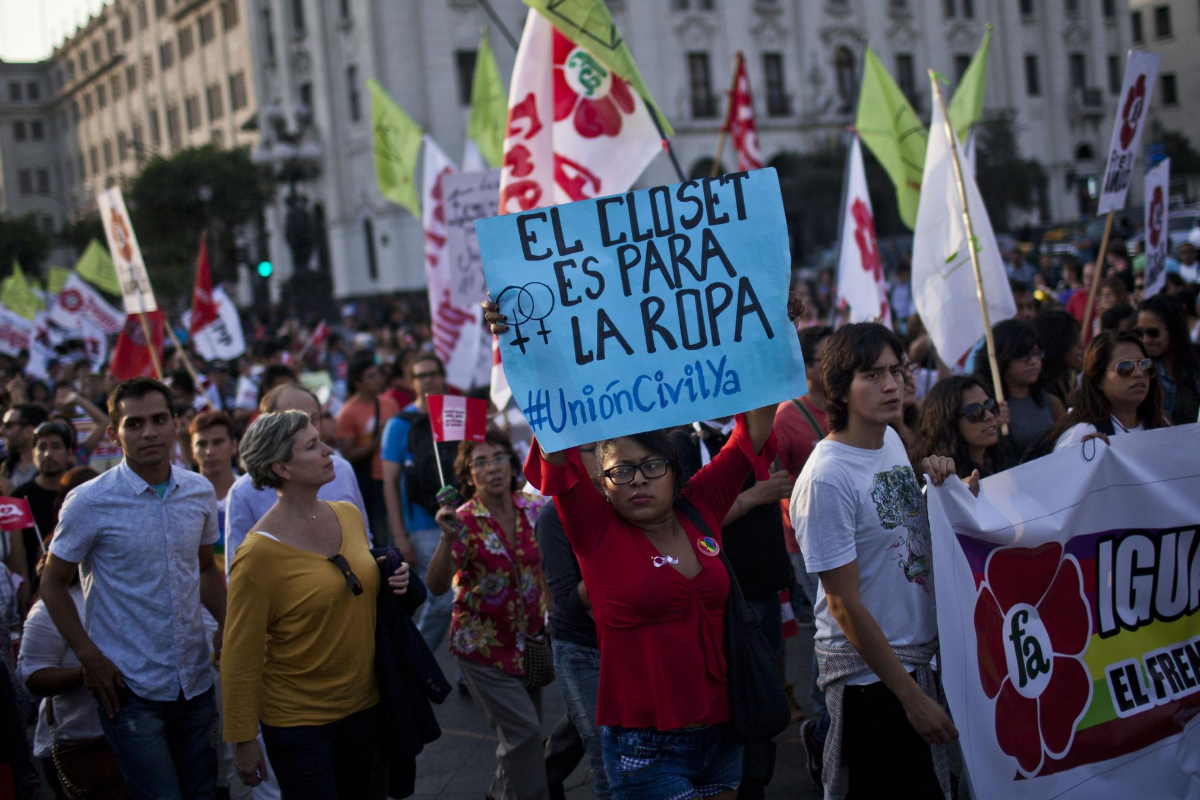

In this April 12, 2014 file photo, people participate in a protest against discrimination and to demand the Peruvian Congress to approve a law that would allow civil unions for same-sex couples. (Photo by ERNESTO BENAVIDES/AFP via Getty Images)
On July 17, a set of rules laying out how populations with a higher risk of suffering attacks against them can access specialized justice was signed among several countries of Latin America. Titled “100 Reglas de Brasilia sobre Acceso a la Justicia de Personas Condicion de Vulnerabilidad”—the document asks that signees to consider rights of vulnerable populations. Peru’s Executive Council of the Judiciary Branch agreed to sign, with one condition: to exclude LGBTQ+ identified people as a vulnerable population. And while days later, this condition was removed, it reflected the ongoing battle for LGBTQ+ rights in Peru.
“There is no trust in the state in general,” said Jorge Chávez Reyes, Director of Movimiento Homosexual de Lima (MHoL). “When you are part of a vulnerable population, your case is accelerated. If we are not included, hate crimes will be forgotten as it often does.”
The President of the Executive Council, Supreme Court Judge José Luis Lecaros, wrote in the resolution in Spanish that “biologically, the existence of the masculine and feminine gender is admissible as well as in normal conditions the sexual orientation can only be heterosexual, meaning, of male and woman and vice versa.”
Several organizations, including MHoL, the Association of Women Judges, the Association of Judges for Justice and Democracy, and the President of the Permanent Commission for the Access to Justice of Persons in Vulnerable Conditions Supreme, called for Judge Lecaros to reconsider his decision.
This past Friday, seven days after his decision was made public, Judge Lecaros retracted his resolution, so that now the mandate include LGBTQ+ as a vulnerable population.
Even though the exclusion was redacted, it showed how the Peruvian state is disconnected from this population which includes up to 8% of Peruvians (that is more than 1.7 million adults) who openly identify as LGBTQ+—the survey was unable to include those who hide their sexual orientation or gender identity due to fear of discrimination.
Moreover, the same survey showed that 71% of Peruvians believe that the LGBTQ+ community is discriminated against in Peru, making it one of the most vulnerable populations. Nonetheless, the same report also showed that 4 out of 10 Peruvians wouldn’t hire a person who identifies as transgender, and 3 out of 10 wouldn’t hire a person who identifies as homosexual.
Organizations like MHoL work to fight discrimination and to assists the community by connecting them to resources they need, such as pro-bono lawyers or NGOs.
“We have 70 to 80 hate crime cases being handled by these organizations, and that is the ones that come forward. Imagine all the other crimes that are not been reported because of fear of retaliation, or fear of being outed and ridicule,” said Chavez Reyes. “There is still a lot of homophobia in Perú, in the population, and unfortunately within the police.”
In April, the government decided that as a way to combat the spread of the COVID-19, it would allow women and men to go out only on certain days (women on Tuesday, Thursdays, and Saturdays, and men on Mondays, Wednesdays and Fridays). President Martín Vizcarra stated while signing the executive order, that gender identity will be honored.
“We know that within gender equality, in its largest concept, there may be citizens who feel different,” said Vizcarra back in April. “The army and police are instructed to not have homophobic attitudes; our government is inclusive.”
However, that same week, three transwomen were detained, ridiculed, recorded and forced to do squats in the police precinct of Bellavista, Callao—they were also forced to yell “I want to be a man; Yo quiero ser hombre.”
In Arequipa, 70 transwomen were evicted and forced to move into shelters. Without resources to buy food, the regional government opened food pantries to their vulnerable population. But, when the pantries were distributed, the women received less items than the rest of the population and they were asked to provide additional documentation to prove they are in a vulnerable situation.
“I don’t feel protected in this country. I don’t feel there is no support from the state,” said Yeefri Peña, a trans woman who survived two murder attempts in Ate Vitarte, in an interview to a local newspaper La República.
While Peña was being assaulted by these men, she heard them scream obscenities at her. People walked right passed her without offering help. When she was able to free herself, she ran to the nearest police precinct for help. But the only answer she allegedly received from the police was: “Solve your problems elsewhere, we are not going to help you.”
According to the Annual LGBT Human Rights Report published last year, there were 49 cases of physical violence against LGBTQ+ identified people. Last year, 4 trans women, 14 gay men, and two lesbians have been reportedly killed in Peru because of their gender identity and sexual orientation, along with 170 discrimination cases. This does not include the countless cases of abuse and systematic discrimination that are not made public.
Even though the government indicated back in April they are inclusive —for the first time in the history of Peru— there is still no law that will protect gender identity and sexual orientation or that will provide the legal protection to the LGBTQ+ population.
***
Diego Jesús Bartesaghi Mena is a 2020 Latino Rebels summer correspondent. A recent graduate of Columbia Journalism School, he is based in Newark, NJ and tweets from @bartesaghi_mena.


